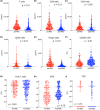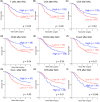Impacts of tumor microenvironment during neoadjuvant chemotherapy in patients with esophageal squamous cell carcinoma
- PMID: 38693726
- PMCID: PMC11309932
- DOI: 10.1111/cas.16203
Impacts of tumor microenvironment during neoadjuvant chemotherapy in patients with esophageal squamous cell carcinoma
Abstract
With the advent of immune checkpoint inhibitors (ICIs), a better understanding of tumor microenvironment (TME) is becoming crucial in managing esophageal squamous cell carcinoma (ESCC) patients. We investigated the survival impact of TME status and changes in patients with ESCC who underwent neoadjuvant chemotherapy (NAC) followed by surgery (n = 264). We examined immunohistochemical status (CD4+, CD8+, CD20+, Foxp3+, HLA class-1+, CD204+, and programmed death ligand-1 [PD-L1+]) on 264 pre-NAC and 204 paired post-NAC specimens. Patients were classified by their pre- and post-NAC immune cell status and their changes following NAC. Our findings showed that pre-NAC TME status was not significantly associated with survival outcomes. In contrast, post-NAC TME status, such as low level of T cells, CD4+ T cells, and high PD-L1 combined positive score (CPS), were significantly associated with poor overall survival (OS). Notably, TME changes through NAC exerted significant survival impacts; patients with consistently low levels of T cells, low levels of CD4+ T cells, or high levels of PD-L1 (CPS) had very poor OS (3-year OS: 35.5%, 40.2%, and 33.3%, respectively). Tumor microenvironment changes of consistently low T cells, low CD4+ T cells, and high PD-L1 were independent predictors of poor OS in multivariate Cox hazards analyses, while factors indicating post-NAC status (T cells, CD4+, and PD-L1 [CPS]) alone were not. Therefore, we suggest that the consistently low T/high PD-L1 group could benefit from additional therapies, such as ICIs, and the importance of stratification by the TME, which has recently been recognized.
Keywords: esophageal squamous cell carcinoma; immune checkpoint inhibitor; neoadjuvant chemotherapy; surgery; tumor microenvironment.
© 2024 The Authors. Cancer Science published by John Wiley & Sons Australia, Ltd on behalf of Japanese Cancer Association.
Conflict of interest statement
The authors declare no conflict of interest.
Figures





Similar articles
-
Correlation of PD-L1 expression with CD8+ T cells and oxidative stress-related molecules NRF2 and NQO1 in esophageal squamous cell carcinoma.J Pathol Clin Res. 2024 Jul;10(4):e12390. doi: 10.1002/2056-4538.12390. J Pathol Clin Res. 2024. PMID: 38992928 Free PMC article.
-
Programmed death-1 ligands and tumor infiltrating T lymphocytes in primary and lymph node metastasis of esophageal cancer patients.Dis Esophagus. 2019 Mar 1;32(3):doy063. doi: 10.1093/dote/doy063. Dis Esophagus. 2019. PMID: 30085020
-
Prognostic value of tumor-infiltrating lymphocytes and PD-L1 expression in esophageal squamous cell carcinoma.Cancer Med. 2024 Sep;13(17):e70179. doi: 10.1002/cam4.70179. Cancer Med. 2024. PMID: 39264227 Free PMC article.
-
Tumor immune microenvironment and immune checkpoint inhibitors in esophageal squamous cell carcinoma.Cancer Sci. 2020 Sep;111(9):3132-3141. doi: 10.1111/cas.14541. Epub 2020 Jul 14. Cancer Sci. 2020. PMID: 32579769 Free PMC article. Review.
-
From tumor microenvironment to emerging biomarkers: the reshaping of the esophageal squamous cell carcinoma tumor microenvironment by neoadjuvant chemotherapy combined with immunotherapy.Front Immunol. 2024 Dec 5;15:1478922. doi: 10.3389/fimmu.2024.1478922. eCollection 2024. Front Immunol. 2024. PMID: 39703499 Free PMC article. Review.
Cited by
-
ASO Author Reflections: Clinical Relevance of Mitochondrial Status in Patients with Esophageal Squamous Cell Carcinoma.Ann Surg Oncol. 2025 Mar;32(3):1987-1988. doi: 10.1245/s10434-024-16573-2. Epub 2024 Dec 2. Ann Surg Oncol. 2025. PMID: 39623186 No abstract available.
-
Expanding horizons in esophageal squamous cell carcinoma: The promise of induction chemoimmunotherapy with radiotherapy.World J Clin Oncol. 2025 Jul 24;16(7):104959. doi: 10.5306/wjco.v16.i7.104959. World J Clin Oncol. 2025. PMID: 40741200 Free PMC article.
-
Survival Impacts of Mitochondrial Status in Esophageal Squamous Cell Carcinoma Patients.Ann Surg Oncol. 2025 Mar;32(3):1963-1972. doi: 10.1245/s10434-024-16533-w. Epub 2024 Dec 7. Ann Surg Oncol. 2025. PMID: 39645554 Free PMC article.
References
-
- Siegel RL, Miller KD, Fuchs HE, Jemal A. Cancer statistics, 2022. CA Cancer J Clin. 2022;72:7‐33. - PubMed
-
- Eyck BM, van Lanschot JJB, Hulshof M, et al. Ten‐year outcome of neoadjuvant chemoradiotherapy plus surgery for esophageal cancer: the randomized controlled CROSS trial. J Clin Oncol. 2021;39:1995‐2004. - PubMed
-
- Kato K, Ito Y, Daiko H, et al. A randomized controlled phase III trial comparing two chemotherapy regimen and chemoradiotherapy regimen as neoadjuvant treatment for locally advanced esophageal cancer, JCOG1109 NExT study. J Clin Oncol. 2022;40:238.
-
- Ando N, Kato H, Igaki H, et al. A randomized trial comparing postoperative adjuvant chemotherapy with cisplatin and 5‐fluorouracil versus preoperative chemotherapy for localized advanced squamous cell carcinoma of the thoracic esophagus (JCOG9907). Ann Surg Oncol. 2012;19:68‐74. - PubMed
MeSH terms
Substances
Grants and funding
LinkOut - more resources
Full Text Sources
Medical
Research Materials

